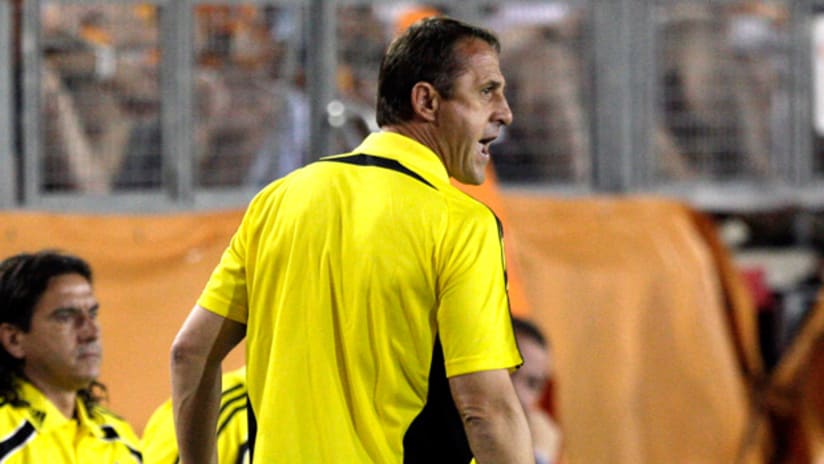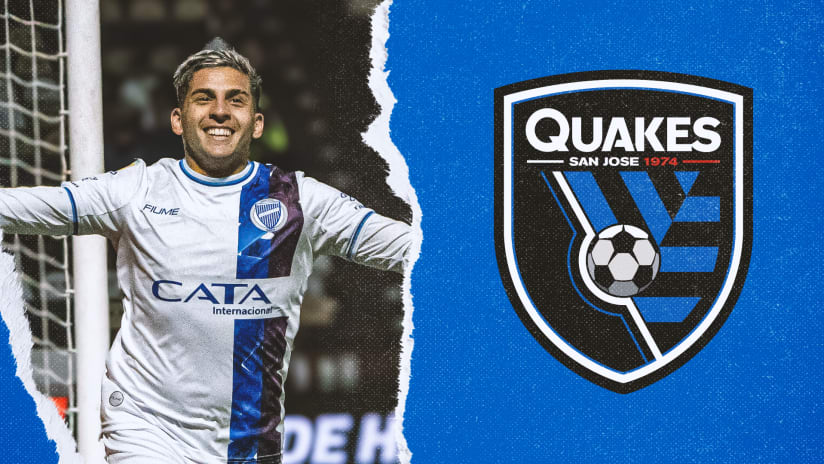The 4-2-3-1 formation has been growing in vogue for years now. So I’ve found myself wondering lately why Major League Soccer teams have been slow to board the train.
The 4-2-3-1, which is anchored in the dual holding midfielders in its current conception, has been around since the 1990s. France’s successful deployment of the system in the 1998 World Cup—and again in the 2000 European Championship, which Les Bleus also claimed—cranked the system’s real-world credibility up to 11.
Spain’s La Liga was the first high-profile domestic association to adopt wide-scale use; by 2000 a majority of La Liga clubs were 4-2-3-1 devotees. Their adoption helped the concept gain more steam through the following decade, and look at where we are today: About half the teams at the World Cup in South Africa played some version of the system.
So why does it seem utterly verboten around MLS?
The Columbus Crew come closest to employing it. Their set-up provides a good example of how a 4-4-2 can easily reshape itself into something that looks just like a 4-2-3-1.
If a forward in a 4-4-2 drops back regularly, as Guillermo Barros Schelotto does so effectively, and if the wingers push forward, then it’s essentially a 4-2-3-1. In Columbus’ case, Brian Carroll usually plays a little deeper than Adam Moffat in the central midfield areas, so the Crew don’t use two holding midfielders, per se.
And whereas Emmanuel Ekpo or Robbie Rogers—when healthy—do tend to play up high on the left side, Eddie Gaven on the right doesn’t start out as wide or as high. So, it’s really a 4-4-2 that sometimes takes on some of its sister system’s characteristics.
The Seattle Sounders play similarly, which is no coincidence since Sigi Schmid installed the systems in both places. Nathan Sturgis has recently been partnered alongside Osvaldo Alonso in the middle of Seattle’s midfield, while Fredy Montero drops into the hole behind target striker Blaise Nkufo.
Simultaneously, the attack has taken on more of a diamond look (characteristic of the 4-2-3-1) as speedsters Sanna Nyassi and Steve Zakuani menace on the right and left flanks, respectively. (Last week it was new DP Álvaro Fernández in place of the injured Zakuani on the left, so the Sounders lost a little width in the 0-0 tie with Chivas USA.)
Again, just like the setup in Columbus, Sturgis tends to play a little higher than Alonso and less as a second holding midfielder. Would the more rigid structure of a true 4-2-3-1 benefit Seattle? Hard to say, but the Sounders are rising lately, so further tinkering seems unwise at this time.
There are also 4-4-2 systems in MLS where two central midfielders do play side-by-side, and do tend to hold in deeper spots. If the outside midfielders push up high and one striker drops into the hole, then it’s effectively a 4-2-3-1—although again without the true, tighter structure.
Chivas USA under its former boss, Preki, looked something like this. Paulo Nagamura and Jesse Marsch assumed the holding roles on some of those dependable Chivas USA teams circa 2008. But what they lacked was a central playmaker. Sacha Kljestan, beginning out wide to protect the 4-4-2 structure, but working inside on attack, was as close as those teams came to that type player.
Thus, lacking that centrally stationed offensive conduit, those workhorse teams may have won more than they lost, but their “Ws” could be hard on the eyes.
So, two questions: Again, why don’t more MLS teams adopt this popular system? And will more teams go this way in the future?
Logically enough, we’ll answer the first question first.
The first requirement of the 4-2-3-1 is to have capable guys to fill the “2” line. What’s needed is a pair of real ball hawks to screen the defense and allow sides to press up a little higher after losing possession. This happens to be a position where the league has some talent, past and present. Shalrie Joseph, Kyle Beckerman, Clyde Simms, Brian Carroll and others have been working the spot in MLS for years.
Plus, there are some real up-and-comers at this position. Tony Tchani was solid last week for the New York Red Bulls, out-performing teammate Rafa Márquez by a wide margin. Fellow rookie central mid Eric Alexander notched a goal and an assist for Dallas. Chivas USA has three good candidates in rookies Blair Gavin and Ben Zemanski, and in sophomore Michael Lahoud.
Guys like Carroll, Simms and the others are good enough in possession and tackling. But perhaps they lack the offensive ideas to perform effectively as all-around, two-way central midfielders. So, why not deploy them with a holding partner, toiling behind an offensive brain in a 4-2-3-1?
Further, to look around the league at teams past and present, you wonder what some holding combos could or would look like. What would Houston look like today, for instance, with Ricardo Clark screening the defense alongside current man Lovel Palmer?
Hmmm. That would work!
(It would never happen, of course, as Dominic Kinnear is clearly wedded to the 4-4-2 and diamond midfield. But there’s nothing wrong with dreaming, eh?)
Would Jason Kreis ever see reason to go with Beckerman alongside Will Johnson in a dual holding capacity? There’s probably no reason at the moment, seeing as the league champs remain in a great place, nipping at LA’s Western Conference’s lead.
Still, if a classic winger type were to fall in the Rio Tinto lap, or if things went a little stale, it might be worth a look-see. They certainly have two of the other elements necessary: a playmaker capable of working the channels behind a striker (Javier Morales) and a target presence comfortable playing with his back to the goal and even more comfortable looking for service in and around the 6-yard box (Alvaro Saborio).
What RSL don’t have is the other needed element, the type of players that we don’t see often enough in MLS: attackers capable of really working those touchlines, finding ways to isolate themselves in 1-on-1 situations and then beating fullbacks on the dribble.
Perhaps that’s why more MLS sides don’t lean toward the 4-2-3-1. Or is it the other way around? More sides don’t have effective wingers because they don’t have the chance, which a 4-2-3-1 might better provide?











